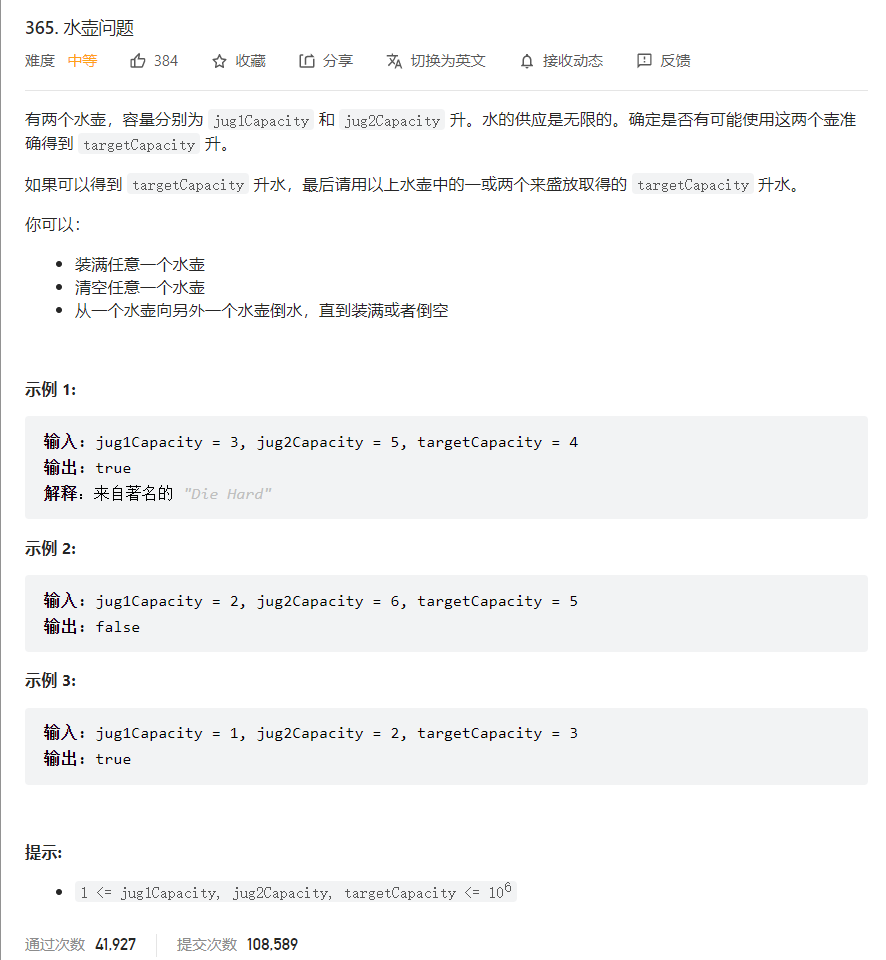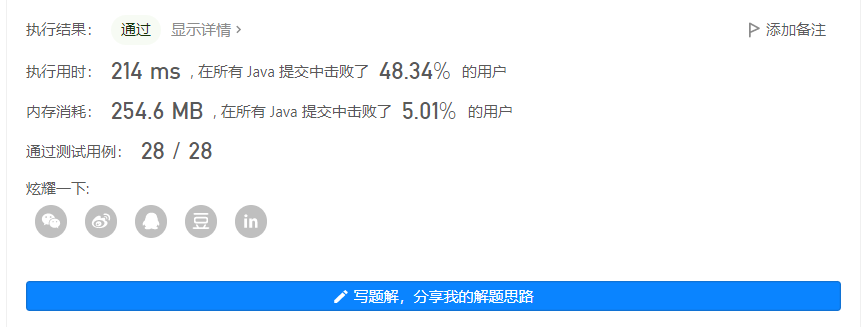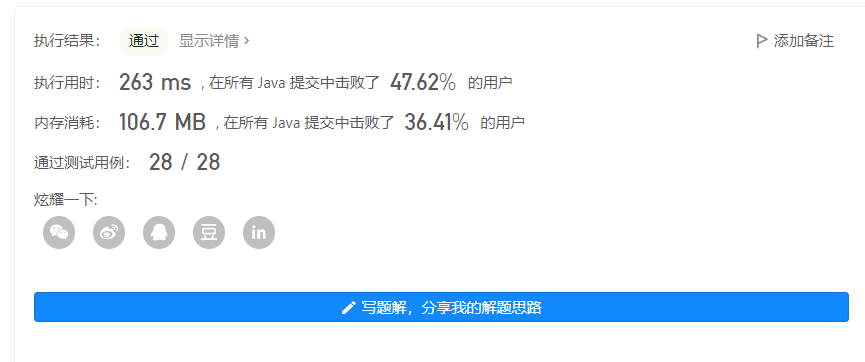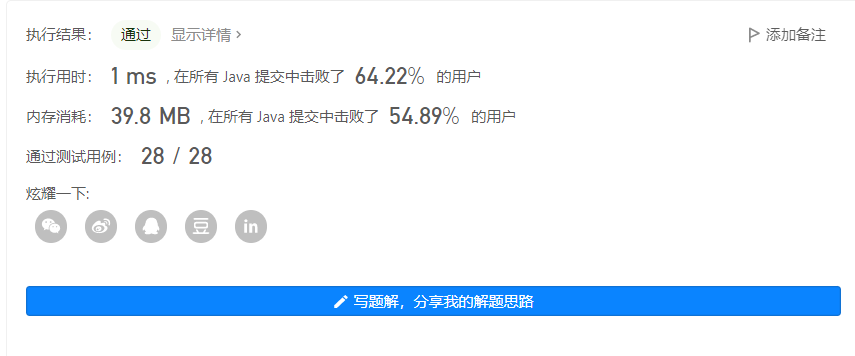🌕🌕 365. 水壶问题
2022年10月10日
- algorithm
🌕🌕 365. 水壶问题
难度: 🌕🌕
问题描述

解法 1 - DFS
class Solution {
HashSet<Long> set = new HashSet<>();
int capX;
int capY;
public boolean canMeasureWater(int jug1Capacity, int jug2Capacity, int targetCapacity) {
// 思路:
// 模拟,假设 2 个水壶分别为 x, y 初始状态下已有水量为 curX, curY,最大容量分别为 capX, capY
// 每次均有 3 种操作
// 1. 装满任意一个水壶 --> [capX, curY] or [curX, capY]
// 2. 清空任意一个水壶 --> [0, curY] or [curX, 0]
// 3. x 倒入 y or y 倒入 x
// 1) x 倒入 y --> [0, curY + curX] or [curX - capY + curY, capY]
// 2) y 倒入 x --> [curX + curY, 0] or [capX, curY - capX + curX]
// 因此可以采用 DFS | BFS 搜索
// 通过 set 去重
capX = jug1Capacity;
capY = jug2Capacity;
if(targetCapacity > capX + capY) {
return false;
}
return mySol(0, 0, targetCapacity);
}
private boolean mySol(int curX, int curY, int targetCapacity) {
// System.out.println(curX + ", " + curY + " ; " + targetCapacity);
// 递归终止条件
if(targetCapacity == curX || targetCapacity == curY || targetCapacity == curX + curY) {
return true;
}
if(set.contains(getHash(curX, curY))) {
return false; // 说明出现了循环
} else {
set.add(getHash(curX, curY));
}
// situation 1 - 只有往空壶中倒满水才有意义
if(curX == 0) {
if(mySol(capX, curY, targetCapacity)) {
return true;
}
}
if(curY == 0) {
if(mySol(curX, capY, targetCapacity)) {
return true;
}
}
// situation 2
if(curX > 0) {
if(mySol(0, curY, targetCapacity)) {
return true;
}
}
if(curY > 0) {
if(mySol(curX, 0, targetCapacity)) {
return true;
}
}
// situation 3
if(curX + curY <= capY) {
if(mySol(0, curX + curY, targetCapacity)) {
return true;
}
} else {
if(mySol(curY + curX - capY, capY, targetCapacity)) {
return true;
}
}
if(curX + curY <= capX) {
set.add(getHash(curX + curY, 0));
if(mySol(curY + curX, 0, targetCapacity)) {
return true;
}
} else {
if(mySol(capX, curY + curX - capX, targetCapacity)) {
return true;
}
}
return false;
}
private long getHash(int a, int b) {
// 将 2 个32位 int 数转为一个 long 值
long res = (long)((long)a << 32) + b;
return res;
}
}
输出 1

解法 2 - BFS
class Solution {
HashSet<Long> set = new HashSet<>();
int capX;
int capY;
public boolean canMeasureWater(int jug1Capacity, int jug2Capacity, int targetCapacity) {
// 思路:
// 模拟,假设 2 个水壶分别为 x, y 初始状态下已有水量为 curX, curY,最大容量分别为 capX, capY
// 每次均有 3 种操作
// 1. 装满任意一个水壶 --> [capX, curY] or [curX, capY]
// 2. 清空任意一个水壶 --> [0, curY] or [curX, 0]
// 3. x 倒入 y or y 倒入 x
// 1) x 倒入 y --> [0, curY + curX] or [curX - capY + curY, capY]
// 2) y 倒入 x --> [curX + curY, 0] or [capX, curY - capX + curX]
// 因此可以采用 DFS | BFS 搜索
// 通过 set 去重
capX = jug1Capacity;
capY = jug2Capacity;
// 特殊情况特判
if(targetCapacity > capX + capY) {
return false;
}
if(targetCapacity == capX + capY) {
return true;
}
// BFS
LinkedList<Long> queue = new LinkedList<>();
HashSet<Long> set = new HashSet<>();
// 压入初始状态
queue.offer(getHash(0, 0));
while(!queue.isEmpty()) {
int len = queue.size();
for(int i = 0; i < len; i ++) {
long cur = queue.poll(); // 获取当前状态
if(set.contains(cur)) {
continue;
} else {
set.add(cur);
}
// 根据队列中的值转换为 x & y
int[] tmp = hashBefore(cur);
int curX = tmp[0];
int curY = tmp[1];
// System.out.println(Arrays.toString(tmp));
// 判断当前 cur 是否满足条件
if(targetCapacity == curX || targetCapacity == curY || targetCapacity == curX + curY) {
return true;
}
// situation 1 尝试
if(curX == 0) {
// 只有杯子空时倒满才有用,半满的杯子倒满无意义,相当于从空杯倒满
long tmp1 = getHash(capX, curY);
queue.offer(tmp1);
}
if(curY == 0) {
long tmp1 = getHash(curX, capY);
queue.offer(tmp1);
}
// sit2
if(curX > 0) {
// 只有杯子有水时,清空杯子才有意义
long tmp1 = getHash(0, curY);
queue.offer(tmp1);
}
if(curY > 0) {
long tmp1 = getHash(curX, 0);
queue.offer(tmp1);
}
// sit3
if(curX + curY <= capY) {
long tmp1 = getHash(0, curX + curY);
queue.offer(tmp1);
} else {
long tmp1 = getHash(curX - capY + curY, capY);
queue.offer(tmp1);
}
if(curX + curY <= capX) {
long tmp1 = getHash(curX + curY, 0);
queue.offer(tmp1);
} else {
long tmp1 = getHash(capX, curY - capX + curX);
queue.offer(tmp1);
}
}
}
return false;
}
private int[] hashBefore(long input) {
int[] res = new int[] {0, 0};
res[0] = (int)(input >>> 32);
res[1] = (int)input;
return res;
}
private long getHash(int a, int b) {
// 将 2 个32位 int 数转为一个 long 值
long res = (long)((long)a << 32) + b;
return res;
}
}
输出 2

解法 3 - 数学
class Solution {
HashSet<Long> set = new HashSet<>();
int capX;
int capY;
public boolean canMeasureWater(int jug1Capacity, int jug2Capacity, int targetCapacity) {
// 思路:
// 模拟,假设 2 个水壶分别为 x, y 初始状态下已有水量为 curX, curY,最大容量分别为 capX, capY
// 每次均有 3 种操作
// 1. 装满任意一个水壶 --> [capX, curY] or [curX, capY]
// 2. 清空任意一个水壶 --> [0, curY] or [curX, 0]
// 3. x 倒入 y or y 倒入 x
// 1) x 倒入 y --> [0, curY + curX] or [curX - capY + curY, capY]
// 2) y 倒入 x --> [curX + curY, 0] or [capX, curY - capX + curX]
//
// 以上 3 种操作中,
// 1. 导致 整体 + capX | + capY
// 2. 导致 整体 - capX | - capY
// 3. 导致 整体水量不变
//
// 也就是说,
// 无论怎么变换,可以通过公式 a*capX + b*capY 表示
// 即找到满足条件的 a & b 使得 a*capX + b*capY = targetCapacity
// 即找到 capX & capY 的最大公约数 c,判断 targetCapacity 是否为 c 的倍数
// 如何找到 2 个数的最大公约数?
// 循环取余,每次找到较大的数,让其减去较小数,直到 2 个数相等,即为最大公约数
capX = jug1Capacity;
capY = jug2Capacity;
// 特殊情况特判
if(targetCapacity > capX + capY) {
return false;
}
if(targetCapacity == capX + capY) {
return true;
}
int c = mySol(capX, capY);
return targetCapacity % c == 0;
}
private int mySol(int a, int b) {
if(a < b) {
int tmp = a;
a = b;
b = tmp;
}
// a >= b
if(a == b) {
return a;
}
// a > b
return mySol(a - b, b);
}
}
输出 3
